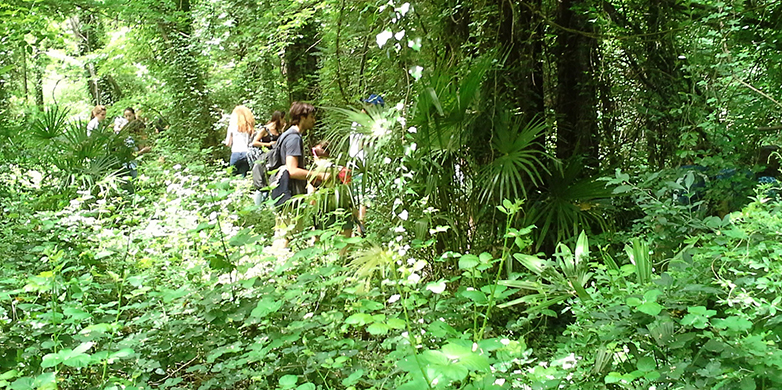Let us out!
Smartphones, not identification keys; biodiversity, not species memorisation: Environmental scientists’ field trips are now a lot more practical. The fact that they can go on field trips at all comes down to the students’ own persistence.

Explaining how his students fought to save the field trips, Urs Brändle, educational developer at the Department of Environmental Systems Science, can’t conceal a note of pride: “It’s a good example of student participation in our department.” The bone of contention in the new, revised curriculum was the systematic field trips. In the first draft, they were envisaged only for specific specialisations. “There’s an enormous amount of organisational work involved,” Brändle says in defence of the decision. But the students weren’t prepared to take no for an answer. “They campaigned hard to be able to continue to study in the field,” he remembers. Today, the field trips are still part of the programme – albeit with a different objective.
Biodiversity, not species memorisation
In the past, the field trips aimed at deepening systematic knowledge. The students spent their time in the field identifying a wide range of plant species. Now the focus is on biodiversity. “This is a hugely important topic for environmental scientists,” Brändle says. “And not only for those who go on to work in an environmental agency.” From insects and waterfowl to grasses and lichen: by using different groups of organisms to bring biodiversity to life, the field trips aim to sharpen students’ awareness of their natural surroundings.
Andrea Funk, who also studied environmental sciences at ETH and now coordinates the field trips, points out: “While knowledge of species is certainly important, we have decided to pursue an exemplary approach to the subject.” That’s why students only need to be familiar with one to two dozen species in each group of organisms – of course, bearing in mind that this is only a very small part. “Anyone wishing to look into the subject in more depth will find a broad range of courses on offer in subsequent semesters,” she says.
Into the field well-prepared
The field trips take place in the form of half-day modules. From the 14 different options on offer, the Bachelor’s students select 6. In the first week of the semester, experts and the some 140 students meet for an introductory session. As well as hearing lectures on biodiversity monitoring, they practise mobile data capture using their own smartphones. But before they get to go out into the field, the students must first pass an online test about the species relevant to the module they’ve selected, which they can prepare for with the help of images and videos.
The field trip begins with a review of the species. “In practice, the reality is quite different from doing exercises on the computer,” Funk says. “There, all you have to do is press a button and the bird sings, but it doesn’t work like that in nature.” Flora and fauna also look far more individual in the field than the textbook example on a photo. Once they have a firm grasp of the subject matter, the students start to look for and record the species in the field.
Depending on the module, they cover a particular route and chart or count the population of flora, lichen, birdcalls or spider webs, for example. They determine their position with the help of their smartphones. Finally, the students and experts evaluate the first data in situ.
In the plenary evaluation session held at the end of the semester it’s not just about biodiversity, however. “For me, a critical appraisal of the quality of the data is just as important as the environmental question,” Brändle points out, and gives an example. In the arachnids module, with the help of the webs the students are also tasked with determining the species. And since it’s easy to make mistakes, the experts discuss with the students how many data sets they need so that the identification errors become inconsequential. “In the age of big data, the data aspect goes far beyond the boundaries of ecology,” Funk adds.
More minds, more expertise
That this field trip involves a lot of effort comes as no surprise. Brändle is therefore pleased that the burden of organising the field trips is now distributed among a number of chairs and institutes. The 46 half-day field trips are mentored by a dozen experts and additional student employees. This broadens the scope of subjects and offers greater choice.
However, it also means more coordination work and increased initial effort for first-time preparation and implementation: apart from the online materials for student preparation and data capture, the algorithm for assigning the students to the half-day field trips was also redeveloped from scratch. In order to manage this task, Brändle launched an Innovedum project, which provided funding for two part-time positions for a period of one year. “This is extremely valuable,” Brändle says. “Innovedum makes it possible to finance extracurricular activities, such as establishing these field trips,” he adds. Following the successful pilot trips last year, he is now looking forward to finally starting the new course proper.
This article appears in the current issue of Globe.
